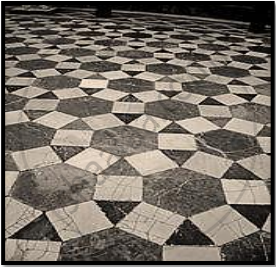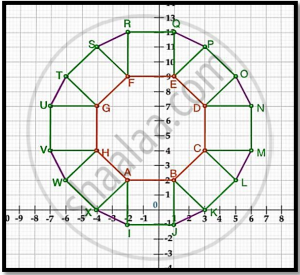Advertisements
Advertisements
Question
If points A (5, p) B (1, 5), C (2, 1) and D (6, 2) form a square ABCD, then p =
Options
7
3
6
8
Solution
The distance d between two points `(x_1 ,y_1) and (x_2 , y_2)` is given by the formula
` d= sqrt( (x_1 -x_2)^2 + (y_1 - y_2)^2)`
In a square all the sides are equal to each other.
Here the four points are A(5,p), B(1,5), C(2,1) and D(6,2).
The vertex ‘A’ should be equidistant from ‘B’ as well as ‘D’
Let us now find out the distances ‘AB’ and ‘AD’.
`AB = sqrt((5-1)^2 + (P -5)^2)`
`AB = sqrt((4)^2 + (p -5)^2)`
`AD = sqrt((5-6)^2 + (p-2)^2)`
`AD = sqrt((-1)^2 + (p-2)^2)`
These two need to be equal.
Equating the above two equations we have,
AB = AD
`sqrt((4)^2 +(p -5)^2 ) = sqrt((-1)^2 + (p-2)^2)`
Squaring on both sides we have,
`(4)^2 +(p -5)^2 = (-1)^2 + (p - 2)^2`
`16+p^2 + 25 - 10 p = 1 + p^2 + 4 - 4p`
6p = 36
p = 6
APPEARS IN
RELATED QUESTIONS
(Street Plan): A city has two main roads which cross each other at the centre of the city. These two roads are along the North-South direction and East-West direction.
All the other streets of the city run parallel to these roads and are 200 m apart. There are 5 streets in each direction. Using 1cm = 200 m, draw a model of the city on your notebook. Represent the roads/streets by single lines.
There are many cross- streets in your model. A particular cross-street is made by two streets, one running in the North - South direction and another in the East - West direction. Each cross street is referred to in the following manner : If the 2nd street running in the North - South direction and 5th in the East - West direction meet at some crossing, then we will call this cross-street (2, 5). Using this convention, find:
- how many cross - streets can be referred to as (4, 3).
- how many cross - streets can be referred to as (3, 4).
If the point C ( - 2,3) is equidistant form the points A (3, -1) and Bx (x ,8) , find the value of x. Also, find the distance between BC
If (2, p) is the midpoint of the line segment joining the points A(6, -5) and B(-2,11) find the value of p.
If the point `P (1/2,y)` lies on the line segment joining the points A(3, -5) and B(-7, 9) then find the ratio in which P divides AB. Also, find the value of y.
ABCD is a rectangle whose three vertices are A(4,0), C(4,3) and D(0,3). Find the length of one its diagonal.
Find the point on x-axis which is equidistant from points A(-1,0) and B(5,0)
Show that A (−3, 2), B (−5, −5), C (2,−3), and D (4, 4) are the vertices of a rhombus.
Find the value of a for which the area of the triangle formed by the points A(a, 2a), B(−2, 6) and C(3, 1) is 10 square units.
Write the distance between the points A (10 cos θ, 0) and B (0, 10 sin θ).
If the distance between the points (3, 0) and (0, y) is 5 units and y is positive. then what is the value of y?
If P (2, p) is the mid-point of the line segment joining the points A (6, −5) and B (−2, 11). find the value of p.
Find the coordinates of the point which is equidistant from the three vertices A (\[2x, 0) O (0, 0) \text{ and } B(0, 2y) of ∆\] AOB .
The ratio in which the line segment joining points A (a1, b1) and B (a2, b2) is divided by y-axis is
What is the nature of the line which includes the points (-5, 5), (6, 5), (-3, 5), (0, 5)?
Find the point on the y-axis which is equidistant from the points (5, −2) and (−3, 2).
Write the X-coordinate and Y-coordinate of point P(– 5, 4)
In which ratio the y-axis divides the line segment joining the points (5, – 6) and (–1, – 4)?
A tiling or tessellation of a flat surface is the covering of a plane using one or more geometric shapes, called tiles, with no overlaps and no gaps. Historically, tessellations were used in ancient Rome and in Islamic art. You may find tessellation patterns on floors, walls, paintings etc. Shown below is a tiled floor in the archaeological Museum of Seville, made using squares, triangles and hexagons.

A craftsman thought of making a floor pattern after being inspired by the above design. To ensure accuracy in his work, he made the pattern on the Cartesian plane. He used regular octagons, squares and triangles for his floor tessellation pattern

Use the above figure to answer the questions that follow:
- What is the length of the line segment joining points B and F?
- The centre ‘Z’ of the figure will be the point of intersection of the diagonals of quadrilateral WXOP. Then what are the coordinates of Z?
- What are the coordinates of the point on y-axis equidistant from A and G?
OR
What is the area of Trapezium AFGH?
The coordinates of the point where the line 2y = 4x + 5 crosses x-axis is ______.
Assertion (A): The point (0, 4) lies on y-axis.
Reason (R): The x-coordinate of a point on y-axis is zero.
